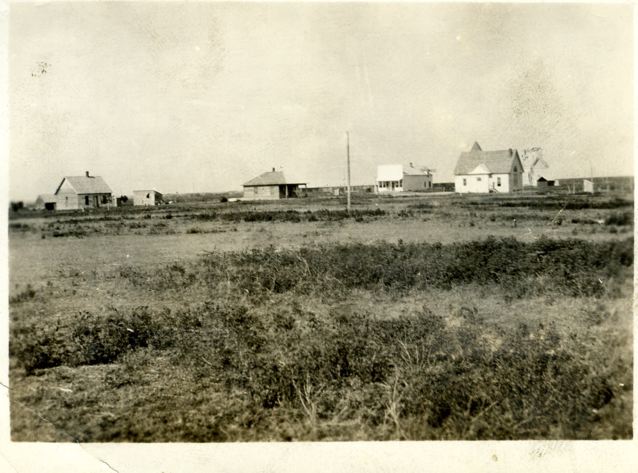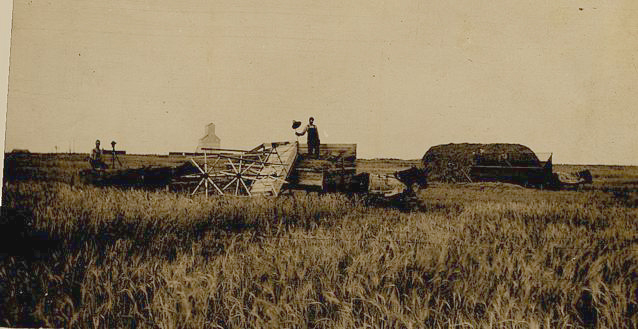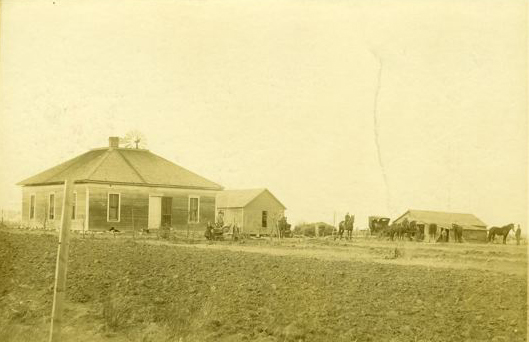
photo: courtesy of John Hutcherson

photo: courtesy of John Hutcherson
From R to L are the railroad elevator in the background, the Methodist Church and the old store-pool room. Present Highway 36 would be running between the church and the other buildings. The Burlington RR was on the other side of the grain elevator.
|
My grandfather Albert Lincoln Hicks gave the land for the church. He came to Norton County in 1884 and was engaged in public school work and farming. My mother, Leta (Hicks) Hutcherson was born in their first home, a soddie, 1/2 mile south of Reager. Madge (Hicks) Sanderson, my mother's sister, and her husband Joseph Sanderson moved the church building to Norton where they occupied it as a home. I remember the old store in the 1940's when it was used as a grocery store. There was still a pool table in the back. John Hutcherson, email, 22 July 2007 |

photo courtesy John Hutcherson

| The house sat on the land "kitty corner" across
from the general store. The posed picture shows the baby bed out front
with the children all holding horses, astraddle horses or sitting in the
buggy. I had occasion to visit the old home and it was a totally
uninsulated 3 bedroom home for parents and 10 children. email from John
Hutcherson, 22 July 2007
This side of the house faced east, toward Norton. This homestead is NOT shown in the view of Reager above. |
I, Ellen Collins Anderson, was asked by Mrs. George Preston of the Norton County Historical Society to gather material and write the history of Reager, Kansas. I was born and reared 2 miles south and 1/2 mile west of Reager. I was not able to find one living pioneer nor an immediate member of a pioneer family. I hope you will bear with me and forgive me if I have left anyone out that should have been mentioned, and if I might have dates and names wrong.
My husband, Ernest, and I started our search at the Norton County Courthouse and gathered information about land grants and patents in an area eight miles in each direction from Reager, understanding that there was no "town" at first.
The Federal Government land allotments terms were quite liberal. The Homestead Act of 1882 stated, anyone over 21 years of age was allowed 160 acres for a homestead by "improving" it and living on it for 5 years. A Timber Claim was also 160 acres, if you would plant ten acres of trees, keeping them growing in good condition for 10 years. You could also file on 160 acres on "presumption" clam by being under 18 years and holding the land until age 21. One could also file on 160 acres against a long term purchase plan, giving $1.25 per acre spread over 20 years.
The data Ernest compiled from the early records in the Norton County Courthouse on the earliest pioneers surrounding Reager are as follows:
W.W. Reager - 1892
L. W. Hicks, Sr. - 1893 (handwritten
addition: Wright Hicks, father of Albert L.)
McCabe - 1895
Wm. Strayer - 1889
The following are early settlers --dates
of patent are unknown, but are probably in the middle and late 1880's:
| Elsie F. Ward | Wm. Lorimer |
| Lewis L. Covey | Wm. McCabe |
| S. N. Johnson | Winfield Scott Reager |
| John W. Howland | John Eagleberger |
| Sarah G. Murray | Athol Davis |
| Hugh Collins | |
| Jonathon Kelly |
To these early, hardworking pioneers and their children, a grain elevator, general store, church and school, post office, railroad and depot with stockyards meant a city would soon come into being. They had the real pioneer spirit. They got behind, pushed, boosted and worked hard all the time for the betterment of the place they called home.
In the early 1880's, W. W. Reager, an early pioneer, had a sod house 1/2 mile south of Reager on the east side of the road, which was used for a school house and church. A Miss Vessey was the teacher. Other early teachers were Albert L. Hicks, O'Hare, Steele, McCabe, Ward, Miller, Williams, Blue, Connel, Reager, Davis, Martin, Howland, Murray, Kelly, Young, Hart, Wheelock, Redd, Eighmy and Keener. Another early teacher at the sod house was Homer Hale. (handwritten additions: Hicks Family had a sod house 1 mile south on west side of road. L. Wright Hicks followed his son, Albert Lincoln to Reager.)
2.
Soon another acre of land was given as school land by W. W. Gardner in the south-east corner of the section, and a frame school house was erected by my grandfather, William Louis Collins, Sr., Fred Garton, Athol Davis, and likely many other contributors. This school was the 49th in Norton County and was known as District 49. Some of the early teachers were: Albert Lincoln Hicks (Al), and Nora Eppinger in 1901. Salaries were $12 per month. Ellen Collins in 1902 received $15 per month. She had 40 pupils and all 8 grades. some of the following teachers were June Kious, Bell and Hazel Venrick, Leta Carter, Ora Davis, Zoe Goodman, Gladys Hicks and Mary Madge Hicks Sanderson. In 1916 her salary was $35 per month. She had 34 pupils in 8 grades. Gladys and Madge were daughters of Al Hicks. I always called this school "Reager School #49" and this was where I spent my eight years. My teachers were Inez Miller, Lois Hager, ? Lovewell, Myra Garton, Mildred Young, Lester Hix, and Ethel McCabe. My fellow students were Lewis, Elwood, Littleton, John and Theron Collins; Edgar Young; Walter Ritter; Audrey, Verlone and Margaret Lyon; Les, Dorothy and Carl Hix; and Clifton Dawson.
The last teacher to teacher at Reager #49 was Nellie Applegate in 1937. Nellie's pupils were: Venietta Hatcher, Jay Miller, Margaret and Mary Lee Hix, Wanda Lyon, Greta Ritter, Effie Collins and Gordon Hix. Entertainment was visiting Literaries from other districts, spelling bees, Geography and Arithmetic matches, and programs put on by the students, teachers and community. In the early days you had to put on your own entertainment.
In 1937 the frame school-house and church was moved to Norton by Forest Fought and converted into a residence where it still stands at 609 W. Washington. Mrs. Madge [Hicks] not only attended school and Sunday School in this building, but she also spent her first years of marriage to Joe Sanderson at this residence.
After driving many miles with horses or ox-teams for supplies and to get their products to market, early pioneers realized a railroad was a must if they were to survive. There was little labor to be hired and everyone worked for themselves and their neighbors. The few who were more skilled were considered the overseer or boss. Everyone in the neighborhood turned out and worked until the job was done. This included building the railroad, threshing, building, or whatever.
Upon learning that the Burlington RR was built and completed to Oronoque early in 1885 and that Jake Porter was driving for the surveyors and helping them choose the route to be extended to Oberlin, these pioneers set-out to donate their long hours of hard labor, their horses, and scrappers to move dirt and even lay steel to build sidings and roadbed and bridges. The railroad was completed to Reager by harvest 1885.
I remember my father, William Lewis Collins, Jr. telling me that he and his hired hand used all of the horses they could find. It would take 4 horses on a scraper to move the dirt. The horses played out by noon, so a new team would be brought in.
3.
They would work from sun-up to sun-down -- a 16 hour day was usual, and usually three or four teams of four horses. the men came from as far away as Sappa, the Nebraska line. During all of the weeks of work only one man was injured -- Albert Hicks. Later a siding was completed and a box car was brought in as a depot for the City of Reager. A lot of freight, cans of cream, livestock and grain was brought to the depot to ship to near-b7 towns and cities.
a grain elevator was built near the railroad and next to that a country store. It served as a community gathering place. There was a pool talbe in the west end of the building. The store was closed when the owner married and moved to Iowa. Wes Lyon reopened the store briefly; then Marjorie and Edgar Young bought it, put in a filling station, and a cafe, and once again it became a busy place. In 1956 they sold it to Mr. and Mrs. Loyd Britigan, but for reasons of health they closed it and moved to Norton in 1966.
The elevator was never closed all these years, a busy place for grain farmers from all around Reager. Over the years it has been managed by Hoyt Linton, Bert Conover, Wm. Scott, John Heller, and Neil Johnson. The Garvey Co. of Wichita last owned it, until it was torn down in 1979.
Due to drought, dust storms, nearness to other towns, and good roads Reager has gone the way of many other small towns on the plains.
|
This history was compiled by Ellen (Collins) Anderson |
|
June 1, 1979 |
(additional
handwritten notes:
copied by Robert C. Long from some nearly unreadable typed pages of Ellen
Collins Anderson - there may be more!
Albert Lincoln Hicks and his family, first five of ten children, lived in a soddy south of Reager. He was a school teacher-farmer.
Wright Hicks, his father, was a physician-politician. I don't think he practiced medicine after moving to Kansas. He did serve in the Kansas Legislature - and was disappointed that no one ever seemed to agree with him. He was a member of the Whig Party which gradually faded away after the Civil War.)
Transcribed by Ardie Grimes from information generously donated by John Hutcherson, 22 July 2007